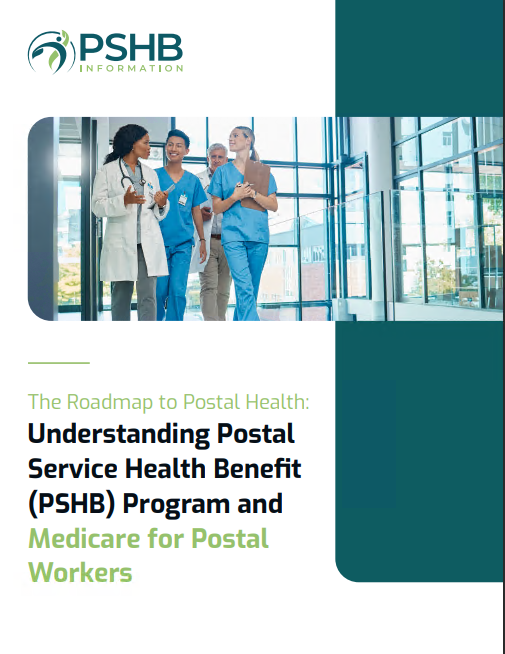Key Takeaways:
- The new Postal Service Health Benefits (PSHB) program launches on January 1, 2025, replacing the Federal Employees Health Benefits (FEHB) for postal employees and retirees.
- While many aspects of coverage remain the same under PSHB, there are notable differences, including the enrollment process and certain plan options.
Understanding the Shift from FEHB to PSHB
As a USPS worker or retiree, you might be wondering what the transition from the Federal Employees Health Benefits (FEHB) program to the Postal Service Health Benefits (PSHB) means for you. Whether you are currently enrolled in FEHB or planning to enroll, this change impacts your health coverage. To help you navigate this transition, we’ll break down what stays the same, what’s different, and how it affects you and your dependents.
The new PSHB program will officially replace FEHB for USPS employees and retirees starting on January 1, 2025. However, you’ll need to pay close attention to the PSHB Open Season, which runs from November 11, 2024, to December 9, 2024. During this time, you’ll need to select your health plan for the coming year.
What’s Staying the Same?
Despite the change from FEHB to PSHB, many aspects of your health coverage will remain familiar.
Comprehensive Coverage for Postal Workers and Retirees
One of the biggest concerns you might have is whether your health benefits will change drastically. Thankfully, under PSHB, you’ll still have access to comprehensive health coverage that mirrors much of what FEHB provided. This means you’ll still have access to medical, hospital, and preventive care services. You won’t lose the core coverage you’ve relied on through FEHB, which ensures continuity in your healthcare.
Choice of Plans and Carriers
Another familiar aspect is the ability to choose from a variety of health plans. Just like with FEHB, the new PSHB program will offer a range of plan options from multiple carriers, including nationwide plans and regional ones. You can still select a plan based on your needs, whether that’s low out-of-pocket costs, broader networks, or more extensive coverage.
No Major Changes in Cost-Sharing
The cost-sharing structure, including premiums, deductibles, and copayments, will largely follow what you’ve experienced under FEHB. While individual plans may differ, the overall structure remains the same: you’ll still be responsible for some level of out-of-pocket costs for medical services, just like in the past. This helps ensure a smooth transition, so you won’t face any sudden or overwhelming cost increases.
What’s Different?
Although many aspects of PSHB resemble the FEHB program, there are several key differences that USPS employees and retirees should be aware of. These changes may affect how you enroll in and manage your health coverage.
New Enrollment Requirement for Postal Retirees
One of the most significant differences under PSHB is the mandatory enrollment in Medicare Part B for postal retirees aged 65 or older. Under FEHB, Medicare Part B enrollment was optional, but starting January 1, 2025, it will be required for PSHB enrollees. This change is designed to coordinate federal health benefits with Medicare to provide more comprehensive coverage for retirees.
By enrolling in Medicare Part B, retirees will receive combined coverage from both PSHB and Medicare, potentially reducing out-of-pocket costs for covered services. However, it’s important to factor in the monthly premium for Medicare Part B when budgeting for your healthcare needs during retirement.
Eligibility for PSHB Enrollment
While FEHB was open to all federal employees, PSHB is exclusively for USPS employees, retirees, and their eligible dependents. If you were covered under FEHB but are not a postal employee, your coverage will remain under FEHB. However, if you are part of the USPS workforce, you’ll need to switch to PSHB during the Open Season enrollment period.
For dependents and family members, eligibility rules remain largely unchanged, but it’s important to verify the specific plan requirements during Open Season.
What Are the Enrollment Deadlines for PSHB?
Understanding the key deadlines for enrolling in PSHB is crucial. The PSHB Open Season for 2024 begins on November 11, 2024, and ends on December 9, 2024. This is your window to select a health plan under the new program. Failing to enroll during this period may result in limited options or even loss of coverage for the upcoming year.
The launch date of PSHB is January 1, 2025, which means your selected coverage will go into effect on that date. It’s essential to review your health needs and compare available plans during Open Season to ensure you make the best choice.
How Will PSHB Work With Medicare?
For those approaching retirement or already retired, one of the critical changes is how PSHB interacts with Medicare. If you’re a postal retiree aged 65 or older, you will now be required to enroll in Medicare Part B. This coordination helps reduce the out-of-pocket costs for covered services and ensures that both Medicare and PSHB work together to provide you with comprehensive coverage.
Medicare will become your primary insurer, while PSHB will serve as secondary coverage. This means Medicare will pay first for your medical services, and then PSHB will cover any remaining costs that Medicare doesn’t cover, such as deductibles and coinsurance. This coordination can significantly lower your overall healthcare expenses.
Impact on Retirees Who Opt Out of Medicare Part B
If you choose not to enroll in Medicare Part B, you may face a penalty and lose access to certain PSHB benefits. For retirees, it’s crucial to factor in the potential penalties and higher out-of-pocket costs when deciding whether to enroll in Medicare Part B.
The key takeaway is that if you’re eligible for Medicare, you should enroll in Part B to take full advantage of the coverage offered under PSHB.
How to Prepare for the PSHB Transition?
Preparing for the shift from FEHB to PSHB requires careful planning. Here are a few steps to consider as you approach the PSHB Open Season.
1. Review Plan Options
During the Open Season from November 11 to December 9, 2024, take the time to review all the available plans under PSHB. Compare the plans based on coverage, premiums, deductibles, and out-of-pocket costs to find the best option for you and your family.
2. Verify Eligibility
Make sure you and your eligible family members are included in the new PSHB program. While most USPS employees and retirees will transition to PSHB automatically, it’s always a good idea to confirm your eligibility and avoid any potential gaps in coverage.
3. Enroll in Medicare Part B if Eligible
If you’re 65 or older and eligible for Medicare, don’t forget to enroll in Medicare Part B. This will ensure that your PSHB and Medicare coverage work together seamlessly to lower your healthcare costs. Failure to enroll could result in penalties or loss of benefits under PSHB.
4. Consider Your Retirement Plans
If you’re nearing retirement or already retired, it’s critical to understand how the PSHB program will work in tandem with Medicare. Be sure to budget for both Medicare Part B premiums and any out-of-pocket costs associated with your chosen PSHB plan.
What’s Next for USPS Employees and Retirees?
As you prepare for the upcoming changes, remember that the transition to PSHB is designed to streamline your healthcare benefits while providing continuity in your coverage. However, staying informed about the enrollment deadlines, plan options, and new Medicare requirements is essential.
Whether you’re still working at USPS or enjoying your retirement, the switch to PSHB is a significant change. By understanding what stays the same and what’s different, you can make informed decisions during Open Season and beyond.
Your Health Benefits Matter: Be Ready for the Transition
As a USPS employee or retiree, your health benefits are essential to your well-being. The shift from FEHB to PSHB offers many similarities but also brings important changes. By being proactive during Open Season, enrolling in Medicare when needed, and selecting the right PSHB plan, you can ensure that you and your family receive the healthcare coverage you need without interruption.








